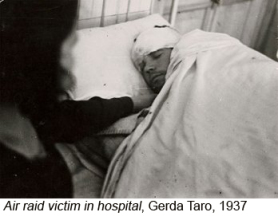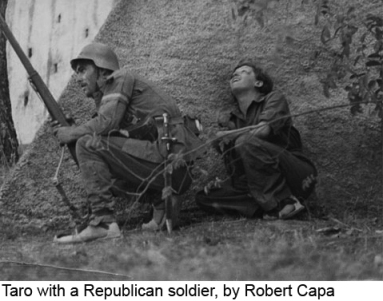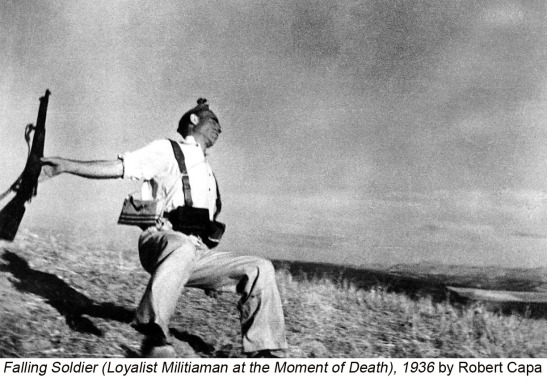Love on the Front Line
 A couple of months ago, I wrote a post about master printer Pablo Inirio and Magnum Photos in which I promised to review the new novel Waiting for Robert Capa. Written by Spanish author Susana Fortes, this novel largely slipped in under the radar last fall when it was issued here—though it will achieve much more prominence in a year or two, when the Michael Mann-directed film adaptation is released.
A couple of months ago, I wrote a post about master printer Pablo Inirio and Magnum Photos in which I promised to review the new novel Waiting for Robert Capa. Written by Spanish author Susana Fortes, this novel largely slipped in under the radar last fall when it was issued here—though it will achieve much more prominence in a year or two, when the Michael Mann-directed film adaptation is released.
I stumbled on the novel while attending an event at the powerHouse Arena in Brooklyn, and was immediately intrigued. There have been a lot of historical novels and movies about artists, from Vermeer to Pollock, but very few about photographers. A notable exception is Helen Humphrey’s beautiful Afterimage, loosely based on the English photographer Julia Margaret Cameron. I loved Afterimage, which I reviewed here.
Waiting for Robert Capa tells the story of Gerta Pohorylle, who changed her name to become Gerda Taro—and who also had the idea of transforming a penniless Hungarian emigré named André Friedmann into the famous war photographer Robert Capa. Initially Capa’s manager, Taro learned how to use a camera and became a war photographer herself. She is often credited as the first woman to photograph at the front line, and died in action during the Spanish Civil War, aged twenty-six—a fact that Fortes reveals fairly early on in a narrative that moves freely back and forth in time.
 Taro’s photographs—which initially went out under Capa’s byline—are different from Capa’s. They’re quieter and more intimate, lacking his wild spontaneity. Her most famous photograph is the one at left, of a female recruit in the Spanish Civil War practicing with her pistol, wearing heels. Some of her other images from Spain can be seen here and here.
Taro’s photographs—which initially went out under Capa’s byline—are different from Capa’s. They’re quieter and more intimate, lacking his wild spontaneity. Her most famous photograph is the one at left, of a female recruit in the Spanish Civil War practicing with her pistol, wearing heels. Some of her other images from Spain can be seen here and here.
The story of this duo was ripe for fictionalizing. Capa was known for his flamboyant personality and daring exploits, and Taro was a proto-feminist who matched him in bravery (and arguably in talent). Their story is an ardent and tragic love affair that moves from the boulevards of Left Bank Paris to the battlefields of Spain, engaging in the politics and passions of the 1930s. What’s not to like?
Well, plenty, it turns out. Other reviewers have complained about everything from the novel’s structure and language to the way it hypes up the romantic elements of the Capa-Taro liaison. This interesting article in Britain’s Guardian newspaper points out that Capa was a notorious womanizer and Taro had other lovers too. They were likely not the everlasting soul mates the novel makes them out to be.
 Despite all this, I have to say that I did end up liking the novel for the most part, with reservations. Mostly, I liked the way Fortes focuses on Taro, who is often a footnote in discussions of Capa. Taro was a charismatic character and talented photographer in her own right, and her struggle to define herself—separate from the bright star that was Capa—is well rendered here. (Focusing on the woman behind a powerful man has been a popular topic of historical novels recently: other entries in this sub-genre include Loving Frank, Clara & Mr. Tiffany, The Paris Wife and Girl in a Blue Dress. I also loved Carol Ann Duffy’s The World’s Wife, a 1999 collection of poems about wives and sisters of big men).
Despite all this, I have to say that I did end up liking the novel for the most part, with reservations. Mostly, I liked the way Fortes focuses on Taro, who is often a footnote in discussions of Capa. Taro was a charismatic character and talented photographer in her own right, and her struggle to define herself—separate from the bright star that was Capa—is well rendered here. (Focusing on the woman behind a powerful man has been a popular topic of historical novels recently: other entries in this sub-genre include Loving Frank, Clara & Mr. Tiffany, The Paris Wife and Girl in a Blue Dress. I also loved Carol Ann Duffy’s The World’s Wife, a 1999 collection of poems about wives and sisters of big men).
In Waiting for Robert Capa, Taro comes across as a thoughtful young woman who learns early on to use her smarts—and her sex appeal—to her advantage. As a young Jew in Stuttgart, she’s arrested by Hitler’s stormtroopers and questioned about her Communist boyfriend. She escapes by charming her guards: “Her captors must have thought that a blond girl, so young and so well dressed, could not be a Communist.” Fleeing to Paris, she joins a community of refugee leftists and soon comes into the orbit of André Friedmann, a charismatic Hungarian Jew trying to make it as a photographer.
 Taro and Capa’s love affair proceeds in fits and starts, with Gerda first evaluating André as “seductive without a doubt; also a tad vulgar, rough around the edges, and lacking in manners.” One night, walking along the Seine, he confides to her that he feels like “a nobody,” and she decides to save him by becoming his manager. Love follows, passionate but complicated, muddied by Capa’s jealousy and Gerda’s determination not to lose her independence.
Taro and Capa’s love affair proceeds in fits and starts, with Gerda first evaluating André as “seductive without a doubt; also a tad vulgar, rough around the edges, and lacking in manners.” One night, walking along the Seine, he confides to her that he feels like “a nobody,” and she decides to save him by becoming his manager. Love follows, passionate but complicated, muddied by Capa’s jealousy and Gerda’s determination not to lose her independence.
Her growth as a photographer complicates things further, as does the chaos of going to war. Fortes does a good job of describing the hurdles Taro had to overcome to be accepted as a female war journalist, at a time when “war was the territory of men. Women didn’t count.” (For an interesting discussion of today’s female war photographers, see here.)
 But Waiting for Robert Capa has some weaknesses, the chief of which is its language. This is one of those novels that is routinely described as ‘lyrical,’ ‘lush,’ and ‘poetic.’ Meaning that it is often very stirring, but it also teeters on an abyss of preciousness, and occasionally drops right in. There are lots of sentence fragments, and a fair amount of lines like this one:
But Waiting for Robert Capa has some weaknesses, the chief of which is its language. This is one of those novels that is routinely described as ‘lyrical,’ ‘lush,’ and ‘poetic.’ Meaning that it is often very stirring, but it also teeters on an abyss of preciousness, and occasionally drops right in. There are lots of sentence fragments, and a fair amount of lines like this one:
Somewhere a war was approaching like a raven wing that would enter through the attic window.
Well, I’m sure it sounded better in Spanish.
There are also many times when Fortes generalizes in a way that tends to grate on my nerves. I don’t like being told what to think or feel, as in these lines:
We all miss something, a house, the street that we played on as kids, an old pair of skis, the boots we wore to school, the book we learned to read with…
We all have a secret fear. A terror that’s intimate, that’s ours, differentiating us from the rest. A unique fear, precise.
Another thing people have criticized in this novel—the way Fortes blends fiction with nonfiction—didn’t bother me so much, though no doubt my fascination with the subject matter helped. I actually kind of liked the way she interrupts the main story to flash forward to Capa’s famous D-Day landing in Normandy, or stops to explain the symbolism of his image, ‘Falling Soldier (Loyalist Militiaman at the Moment of Death)‘—which, she tells us, “contained all the drama of Goya’s Third of May 1808 painting, all the rage that Guernica would later show.”
When it comes to that famous and controversial image—the one that catapulted Capa to stardom as “the world’s greatest war photographer,” and would forever change the way people photograph war—Fortes takes a clear side. Capa biographer Richard Whelan has argued lengthily that the photograph was not staged, as some have claimed, but shot in the heat of battle on the Cordoba front.
Fortes takes another popular view, writing a scene in which Capa explains to Taro that he had asked some soldiers to fake-rush down a hillside during a quiet time, and that one of them was picked off by a sniper. He feels unbearably guilty about this, and remarks to Taro, “the Fascists had riddled him with bullets. But I killed him.”
 Why does Fortes choose this contested version of events? I think because it gives Capa a tragic air that serves the general tone of the novel. Making the image a half-truth is also, possibly, a wry comment on her own role as storyteller. Writing historical novels featuring real people is a tightrope act: you want to stay faithful to the outlines of the person’s life, but also to dramatize it effectively. Fortes obviously bends the truth in several ways (for one thing, Taro was with Capa on the day he shot the falling soldier) but people will differ as to how much this matters. As someone who’s working on a historical novel about a famous photographer, I obviously have some skin in this game, so I’ll just say… it’s fraught.
Why does Fortes choose this contested version of events? I think because it gives Capa a tragic air that serves the general tone of the novel. Making the image a half-truth is also, possibly, a wry comment on her own role as storyteller. Writing historical novels featuring real people is a tightrope act: you want to stay faithful to the outlines of the person’s life, but also to dramatize it effectively. Fortes obviously bends the truth in several ways (for one thing, Taro was with Capa on the day he shot the falling soldier) but people will differ as to how much this matters. As someone who’s working on a historical novel about a famous photographer, I obviously have some skin in this game, so I’ll just say… it’s fraught.
For all the faults of Waiting for Robert Capa, though, I do feel that Fortes conveys Taro in a way that seems emotionally true. She also does a good job of evoking the novel’s colorful settings, from artistic Left Bank Paris to that fateful hillside in Cordoba.
It will be interesting to see what happens when this becomes a film. Generally, I think people seem to accept fictionalization in film much more readily than in novels. Mann’s films are usually restrained, so hopefully he’ll streamline the story and avoid cheesy voiceovers and an over-dramatic score. Gerda Taro deserves that. She also deserves the belated recognition this project is bringing her.
4 comments on “Love on the Front Line”
Leave a Reply
Connecting to %s



The question of writing quality aside, I am struck by this:
“This interesting article in Britain’s Guardian newspaper points out that Capa was a notorious womanizer and Taro had other lovers too. They were likely not the everlasting soul mates the novel makes them out to be.”
So what doesn’t the Guardian reviewer understand about the definition of the word “novel?” It’s fiction. The only question is whether it is good fiction, not whether it is “truthful.”
Thanks, B.D. I agree with you for the most part, but it’s an interesting genre, and people are very protective of their heroes. I’m writing a historical novel and I’ve had a lot of people tell me flat out that they can’t read fiction about real people. Personally I love the genre, but I do occasionally get annoyed when something major is changed for no good reason. I was disappointed, for example, after seeing The King’s Speech when I read that Churchill was never very supportive of Bertie. Having Churchill be unsupportive could have actually made a more interesting movie, but it didn’t fit the writer’s neat and somewhat facile storyline.
Sarah, Well done! I really enjoyed your piece. Now I want to pick up a copy of Waiting for Robert Capa. (I didn’t realize that there was an issue that Capa had staged some of his photos.)
Fascinating read – I’m always suspicious of books/films that are ‘based on a true story’…. but it is about time that Taro got some attention.
For too long she’s just been a footnote in the Capa legend that added another layer of doomed romanticism to him.
The film should be interesting – at least it isn’t a Jerry Bruckheimer production with added car chases….the real life story of Capa & Taro is more than interesting enough.